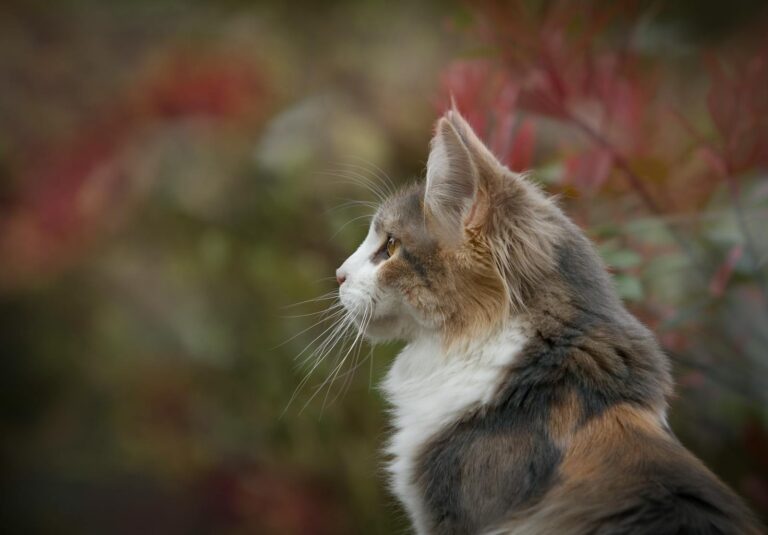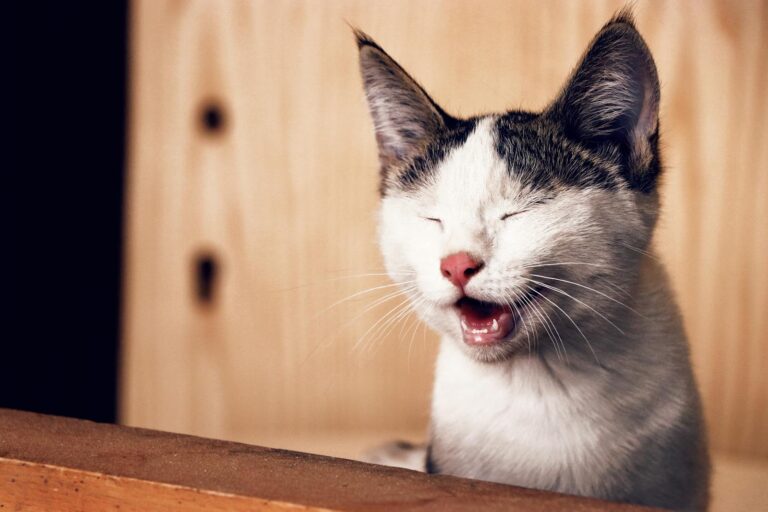Why Do Cats Purr? Science & Theories Explained
Why do cats purr? Science & theories explained. This question has intrigued cat lovers, scientists, and curious minds alike for centuries. Purring is one of the most recognizable sounds produced by our feline companions, yet it remains shrouded in mystery. In this article, we will delve deep into the fascinating world of cat purring, exploring the physiological mechanisms, various theories surrounding this behavior, and its implications for healing and communication.
Introduction: The Enigmatic Purr – Unraveling a Feline Mystery
When we think about cats, the soothing sound of their purr often comes to mind. It’s a gentle vibration that resonates not just in the air but also in our hearts, creating an instant bond between us and our furry friends. Yet, while many pet owners associate purring with contentment, the reality is much more complex.
The act of purring is far from a simple expression of happiness. It serves multiple purposes—some of which are still being discovered by scientists today. Understanding the reasons behind this unique behavior can help us appreciate our feline companions even more and potentially enhance our interactions with them.
In this section, we will explore the physiology of purring and how it occurs, setting the stage for a comprehensive look at the theories and meanings behind this quintessential cat behavior.
The Sound of Purring: Nature’s Whispers
Purring is produced through rhythmic contractions of the muscles within a cat’s larynx, or voice box. These contractions create a rapid opening and closing of the vocal cords, resulting in the soft, vibrating sound we hear. Interestingly, this mechanism is not exclusive to domestic cats; wildcats and other felines, such as cougars and bobcats, also possess the ability to purr, albeit differently.
The pitch and volume of a cat’s purr can vary depending on the situation and the individual cat. Some cats may produce a low rumbling sound, while others may have a higher frequency. Research suggests that these variations might serve different purposes, indicating that purring is more than just a “one-size-fits-all” vocalization.
The Biological Mechanism Behind Purring
Understanding the biological mechanism behind purring requires a closer look at a cat’s anatomy. The process begins when a cat engages its diaphragm—this muscle plays a crucial role in respiration. As the diaphragm contracts and relaxes, it triggers the laryngeal muscles to alternately tense and relax, leading to the characteristic sound of purring.
Research has shown that the frequency of a cat’s purr typically ranges between 25 to 150 Hertz. This range is significant because studies indicate that vibrations within this frequency can promote healing and regeneration in bones and tissues. This revelation opens up new avenues for understanding why cats purr, particularly in the context of self-care.
The Role of Emotion in Purring
While purring is often linked to positive emotions such as relaxation and comfort, it’s essential to recognize that this behavior can also signal distress or pain. For instance, a cat may purr when injured or anxious as a way to self-soothe. Observing your cat’s body language and overall demeanor can provide critical context for interpreting the meaning behind its purring.
Cats sometimes purr while interacting with humans or other animals, creating an emotional connection. As they communicate their feelings, they remind us of the intricate social dynamics that exist within their world. When we listen closely to the nuances of their purring, we begin to understand the depth of their expressions.
The Physiology of Purring: Exploring the Biological Mechanisms
To truly grasp why cats purr, we must examine the physiological processes that enable this intriguing behavior. Not only does purring serve as a form of communication, but it also reveals insights into a cat’s health and emotional state.
The Anatomy of Purring
At the heart of purring lies the larynx, a complex structure composed of several components, including cartilage and soft tissue. The primary actors in the purring process are the laryngeal muscles, which control the tension and position of the vocal cords.
When these muscles contract, they pull the vocal cords tightly together, producing sound. The simultaneous contraction of the diaphragm aids in controlling airflow during inhalation and exhalation, allowing the rhythmical sound of purring to emerge. This intricate interplay between muscles creates a synchronized pattern that characterizes a cat’s purr.
Purring Frequency and Its Significance
The frequency of a cat’s purr has garnered attention from researchers interested in animal behavior and healing properties. Frequencies around 25 to 50 Hertz have been associated with promoting bone growth and healing fractures. This correlation raises compelling questions about whether cats instinctively use purring as a natural healing mechanism.
In fact, some veterinary professionals advocate for the therapeutic benefits of purring. They suggest that encouraging purring in ill or injured cats might aid recovery, demonstrating the fascinating intersection between biology and health in our feline companions.
Factors Influencing Purring Behavior
Several external factors can influence a cat’s tendency to purr. These may include environmental conditions, previous experiences, and individual temperament. For example, a cat raised in a loving home may be more inclined to purr than a feral cat with a history of stress or trauma.
Moreover, each cat is a unique individual, making it crucial for pet owners to consider their cat’s personality when interpreting purring behavior. A cat may purr while lounging comfortably in a sunbeam, signaling contentment, whereas a cat in a stressful environment may purr as a coping mechanism.
Theories on Why Cats Purr: Beyond Contentment
While many people associate purring with a cat’s state of happiness, research and anecdotal evidence suggest a more multifaceted purpose behind this behavior. Various theories have emerged to explain why cats purr, providing insight into their emotional and physical well-being.
The Contentment Theory
One of the most widely accepted theories regarding purring is the contentment theory. Pet owners often observe their cats purring during moments of relaxation—cuddling on the couch or basking in sunlight. This behavior has led to the belief that purring is a sign of a happy cat.
While there may be truth to this notion, it is essential to recognize that purring can occur in a variety of contexts. Even the most contented cat may purr when faced with uncertainty, demonstrating that purring is not solely indicative of pleasure.
The Self-Soothing Mechanism
Another prominent theory posits that purring serves as a self-soothing mechanism. Just as humans may hum or engage in deep breathing exercises to calm themselves, cats may purr to alleviate stress and anxiety. This behavior can be particularly evident when a cat is frightened or in pain.
Research supports this idea, suggesting that the vibrations generated by purring may trigger the release of endorphins—natural painkillers produced by the brain. By purring, cats may effectively tap into their body’s ability to soothe itself during moments of hardship.
The Communication Theory
Purring may also function as a means of communication, both with humans and fellow felines. While purring is often perceived as a gentle sound, it can convey specific messages. For example, a mother cat will purr to her kittens, reinforcing bonds and guiding them toward safety.
Interestingly, some studies suggest that cats modify their purring frequency when interacting with humans. The “solicitation purr” contains a higher pitch and faster tempo, mimicking a baby’s cry. This adaptation may elicit a nurturing response from humans, emphasizing the depth of the human-animal bond.
Purring as a Healing Mechanism: Self-Soothing and Regeneration
Beyond its communicative aspects, the phenomenon of purring has drawn attention for its potential healing properties. The vibrations created during purring appear to play a vital role in self-repair and regeneration.
The Healing Effects of Frequency
As mentioned earlier, the frequency range of a cat’s purr—between 25 to 150 Hertz—is believed to align with frequencies that promote healing. Studies conducted on animals and humans have indicated that vibrations within this spectrum can stimulate tissue regeneration, increase circulation, and reduce inflammation.
This insight aligns with the notion that cats may instinctively engage in purring as a way to support their own health and recovery. Whether after an injury or during periods of stress, purring may offer an innate mechanism for healing.
Purring for Stress Relief
Purring is also thought to provide stress relief not only for cats but perhaps for their human companions as well. The calming sound and vibrations of a cat’s purr can create a soothing environment, reducing anxiety levels for both parties. This mutual benefit strengthens the bond between cats and their owners, enhancing overall well-being.
Furthermore, pet therapy programs often utilize animals known for their calming presence. Cats’ purring may serve as a key component in these therapies, offering comfort to individuals facing challenges such as illness, loneliness, or emotional distress.
Purring and Pain Tolerance
Several studies suggest that cats who experience chronic pain may purr more frequently than their counterparts without pain. This phenomenon could indicate that purring helps cats cope with discomfort, effectively acting as a coping mechanism in challenging situations.
Observing changes in your cat’s purring behavior can be a valuable indicator of its health status. If a cat starts purring excessively or in new contexts, it may warrant further investigation to rule out underlying issues.
Purring for Communication: Signals to Humans and Other Felines
In addition to serving as a self-soothing mechanism and a potential healing tool, purring also functions as a form of communication. The signals conveyed through purring can range from affection to requests for attention or assistance.
Purring as a Social Signal
Cats are inherently social creatures, and their ability to communicate with one another—including through purring—plays a crucial role in their relationships. Mother cats often purr to their kittens, creating a comforting atmosphere while fostering attachment.
Additionally, adult cats may use purring within social groups to establish connections and maintain harmony. The gentle vibrations can signal non-aggression and reassurance, promoting peaceful coexistence among cats.
Purring to Request Attention
While purring is often associated with moments of companionship, it can also serve as a request for attention from humans. When a cat approaches its owner and begins to purr, it may be signaling a desire for interaction, petting, or feeding.
Research indicates that cats may adapt their purring frequency when seeking human attention, making it more appealing to our ears. This evolution demonstrates the adaptive nature of feline communication and their knack for understanding human responses.
Understanding Context Through Observations
Interpreting a cat’s purring requires careful observation of its context and accompanying body language. A relaxed cat that rolls onto its back while purring is likely expressing contentment. Conversely, a cat exhibiting signs of distress, such as flattened ears or dilated pupils, may be using purring to cope with anxiety.
By understanding the nuances of a cat’s behavior, owners can foster stronger bonds and ensure that their cats feel secure and understood.
Conclusion: A Complex Behavior – Further Research and Understanding
In unraveling the mystery of why cats purr, we have explored a rich tapestry of physiological mechanisms, emotional responses, and communication strategies. While the sound of a cat’s purr may evoke images of warmth and contentment, it is essential to recognize the complexity embedded within this behavior.
From serving as a self-soothing mechanism to assisting in healing and fostering social connections, purring remains a multifaceted aspect of feline life. As researchers continue to investigate the depths of cat behavior, we gain deeper insights into how these remarkable creatures navigate their world. By embracing a holistic understanding of purring, we can enhance our relationships with cats and appreciate the profound bond we share with them.
In sum, the inquiry into “why do cats purr?” reveals a beautiful interplay of science, emotion, and communication—an ongoing exploration that invites us to learn more about the enigmatic nature of our beloved feline companions.







